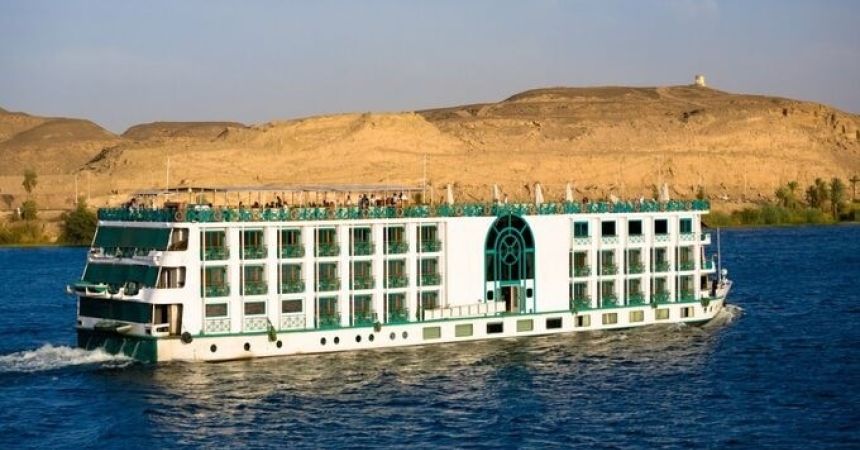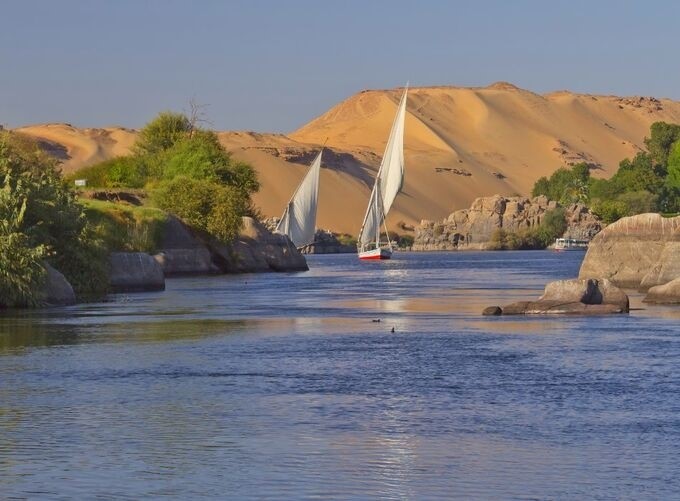
Guide to Cruising the Nile River – Highlights & Tips
Cruising the Nile River is a unique and unforgettable experience that allows travelers to explore Egypt’s rich history, stunning landscapes, and vibrant culture from the comfort of a floating hotel. As the longest river in the world, the Nile has been the lifeblood of Egypt for millennia, shaping its civilization and nurturing its people. This comprehensive guide will cover everything you need to know about cruising the Nile, including planning your trip, choosing the right Nile cruise trip, must-see sites, and tips for making the most of your journey.
Understanding the Nile River
The Nile River stretches over 6,650 kilometers (4,135 miles), flowing through eleven countries in northeastern Africa. It is traditionally divided into two main tributaries: the Blue Nile, which originates in Ethiopia, and the White Nile, which begins in Uganda. The Nile has been central to Egyptian life since ancient times, providing water for irrigation, transportation, and trade.
Historical Significance
The Nile has played a crucial role in the development of Egyptian civilization. Many of Egypt’s most significant archaeological sites, including the Pyramids of Giza and the temples of Karnak and Luxor, are located along its banks. The river's annual flooding deposited nutrient-rich silt onto the surrounding land, enabling agriculture and sustaining life in an otherwise arid landscape.
Planning Your Nile River Cruise
Choosing the Right Cruise
Types of Cruises
- Luxury Cruises: These cruises offer upscale amenities, spacious cabins, gourmet dining, and guided tours of key archaeological sites. Luxury cruises provide a high level of service and comfort, ideal for those looking to indulge.
- Mid-Range Cruises: Offering a balance between comfort and affordability, mid-range cruises typically include well-appointed cabins, decent dining options, and guided excursions.
- Budget Cruises: These cruises are more basic, providing essential amenities and services. They are a good option for travelers looking to save money while experiencing the Nile.
Duration of the Cruise
Nile cruises typically range from three to seven days, depending on the itinerary and the specific sites included. Here are some common routes:
- Luxor to Aswan: This popular route covers key sites like Karnak, the Valley of the Kings, and Abu Simbel.
- Aswan to Luxor: This route typically offers a reverse itinerary, allowing you to explore both cities' highlights.
- Round Trip: Some cruises may offer round-trip itineraries that allow you to explore both Luxor and Aswan with additional stops at various temples and archaeological sites along the way.
When to Go
The best time to cruise the Nile is during the cooler months, from October to April. During this period, temperatures are mild, making it ideal for sightseeing and outdoor activities. Avoid the peak summer months (June to August) when temperatures can soar, making excursions uncomfortable.
Packing Essentials
- Clothing: Lightweight, breathable clothing is ideal for the daytime. Bring a light jacket or sweater for cooler evenings. Modest clothing is recommended, especially when visiting religious sites.
- Footwear: Comfortable walking shoes are essential for exploring archaeological sites. Flip-flops or sandals are great for relaxing on the boat.
- Sunscreen and Sunglasses: Protect yourself from the sun with high-SPF sunscreen and a wide-brimmed hat.
- Camera and Binoculars: Capture the stunning landscapes and wildlife along the Nile.
Must-See Sites Along the Nile in Egypt
Luxor
Overview
Often referred to as the "world's greatest open-air museum," Luxor is home to a wealth of ancient monuments and temples, including the Visit Karnak Temple and the Valley of the Kings.
Key Attractions
- Karnak Temple: This massive temple complex is dedicated to the god Amun-Ra and features impressive hypostyle halls, towering obelisks, and sacred lakes.
- Valley of the Kings: Explore the burial sites of many pharaohs, including the famous tomb of Tutankhamun. The intricate wall paintings and reliefs provide insight into ancient Egyptian beliefs about the afterlife.
- Temple of Hatshepsut: This mortuary temple is dedicated to the only female pharaoh of Egypt and features stunning architecture against a backdrop of cliffs.
Edfu
Overview
Edfu is home to one of the best-preserved temples in Egypt, dedicated to the falcon-headed god Horus. The Temple of Edfu is a must-visit for its impressive architecture and historical significance.
Key Attractions
- Temple of Horus: This temple, built between 237 and 57 BC, features stunning reliefs depicting the mythology of Horus. The temple's impressive columns and massive entrance pylon are highlights of the site.
Kom Ombo
Overview
Located about halfway between Edfu and Aswan, the Temple of Kom Ombo is unique because it is dedicated to two gods: Sobek (the crocodile god) and Horus.
Key Attractions
- Temple of Kom Ombo: This double temple features symmetrical architecture, with separate sanctuaries for Sobek and Horus. The temple is adorned with beautiful carvings, including depictions of ancient surgical instruments.
Aswan
Overview
Aswan is known for its stunning landscapes, Nubian culture, and significant archaeological sites. The city serves as a gateway to some of Egypt's most remarkable monuments.
Key Attractions
- Philae Temple: Dedicated to the goddess Isis, this temple complex is located on Agilkia Island and features beautiful reliefs and stunning architecture.
- Nubian Museum: This museum showcases the history and culture of Nubia, highlighting its contributions to ancient Egyptian civilization.
- High Dam: The Guided tour to Aswan High Dam is an engineering marvel that provides hydroelectric power and regulates the Nile’s flow. Visitors can learn about its significance to Egypt's modern development.

Abu Simbel
Overview
Abu Simbel is a UNESCO World Heritage site featuring two massive rock temples built by Pharaoh Ramses II. The temples are renowned for their stunning architecture and historical significance.
Key Attractions
- Great Temple of Ramses II: The entrance is flanked by four colossal statues of the pharaoh, each standing about 20 meters (66 feet) tall. The interior features intricate carvings and reliefs depicting Ramses' military victories.
- Temple of Nefertari: Dedicated to Ramses’ favorite wife, Nefertari, this temple is adorned with beautiful reliefs and serves as a testament to the pharaoh's devotion to her.
Onboard Experience: What to Expect
Types of Accommodations
- Cabins: Most Nile cruise boats offer comfortable cabins with en-suite bathrooms, air conditioning, and large windows for scenic views. Some luxury cruises may offer suites with additional amenities.
- Dining: Onboard dining typically includes a mix of Egyptian and international cuisine, with meals served buffet-style or à la carte. Many cruises offer themed dinners featuring traditional Egyptian dishes.
Activities and Entertainment
- Guided Excursions: Daily excursions to key archaeological sites are a highlight of Nile cruises, often accompanied by knowledgeable guides who provide insights into the history and significance of each site.
- Evening Entertainment: Many cruises feature evening entertainment, such as traditional music and dance performances, providing a taste of local culture.
- Relaxation: Take advantage of onboard amenities, including swimming, sun decks, and lounges. Many boats have spas offering treatments and massages.
Practical Tips for Cruising the Nile
Booking Your Cruise
- Research Options: Take the time to research various cruise lines and itineraries to find one that suits your preferences and budget.
- Check Reviews: Read reviews from previous travelers to get an idea of the quality of service and experiences offered by different cruise operators.
- Book in Advance: Nile cruises can fill up quickly, especially during peak tourist seasons, so it’s advisable to book your trip in advance.
Health and Safety
- Travel Insurance: Consider purchasing travel insurance that covers health emergencies, trip cancellations, and lost belongings.
- Stay Hydrated: Drink plenty of water, especially during excursions, to stay hydrated in the warm climate.
- Health Precautions: Consult your doctor about vaccinations or medications that may be recommended before your trip.
Currency and Payments
- Local Currency: The currency in Egypt is the Egyptian pound (EGP). It’s advisable to have some cash for local purchases, although credit cards are accepted in many hotels and larger establishments.
- ATMs and Currency Exchange: ATMs are widely available in cities like Cairo and Luxor, and currency exchange services can be found at banks and hotels.
Cultural Etiquette
- Respect Local Customs: Dress modestly, especially when visiting religious sites, and be aware of local customs and traditions.
- Photography: Always ask for permission before taking photographs of people, especially in rural areas, and be respectful of sacred sites.
From the Nile to Ancient Egypt Treasures
Cruising the Nile River is a journey through time, offering travelers the opportunity to explore ancient wonders, vibrant cultures, and stunning landscapes. From the iconic Pyramids of Giza to the breathtaking temples of Abu Simbel, each stop along the river tells a story of Egypt’s rich history and enduring legacy.
As you plan your Nile cruise, take the time to immerse yourself in the experiences and cultural nuances that make this journey truly special. With careful planning, a sense of adventure, and a willingness to embrace the beauty of Egypt, your Nile River cruise will undoubtedly become a highlight of your travel experiences.



